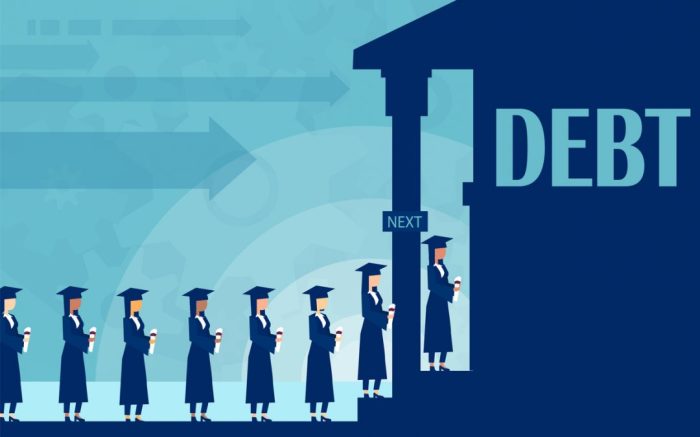Diving into the world of Managing student debt, get ready to explore effective strategies and tips to conquer the financial burden that comes with student loans. This is where the real deal is, so buckle up and let’s ride this financial wave together.
Exploring the ins and outs of student debt and how to navigate the murky waters of loan repayment.
Understanding Student Debt
Student debt refers to the amount of money borrowed by students to pay for college tuition and other educational expenses. This debt must be repaid with interest after the student graduates or leaves school.
Types of Student Loans
- Federal Student Loans: These loans are funded by the government and typically have lower interest rates compared to private loans. They include Direct Subsidized Loans, Direct Unsubsidized Loans, and Direct PLUS Loans.
- Private Student Loans: These loans are offered by banks, credit unions, and other financial institutions. They usually have higher interest rates and are not eligible for federal loan forgiveness programs.
- Parent PLUS Loans: These loans are available to parents of dependent undergraduate students to help cover educational expenses.
Impact of Student Debt
- Individuals: Student debt can have a significant impact on individuals, leading to financial stress, delayed milestones such as buying a home or starting a family, and limited career options due to the need to prioritize repayment.
- Economy: The rising student debt burden can also have broader economic consequences, affecting consumer spending, homeownership rates, and overall economic growth. It can create barriers to entry for young professionals and hinder entrepreneurship and innovation.
Managing Student Debt
When it comes to managing student debt, it’s essential to have a plan in place to ensure you can pay off your loans effectively. Here are some strategies to help you manage your student debt and stay on track with your payments.
Loan Repayment Options
- Income-Driven Repayment Plans: These plans adjust your monthly loan payments based on your income, making it more manageable to pay off your debt over time.
- Refinancing: Refinancing involves taking out a new loan with better terms to pay off your existing student loans. This can help lower your interest rate and monthly payments.
Creating a Budget
- Importance of Budgeting: Creating a budget allows you to track your expenses, prioritize loan payments, and avoid overspending.
- Sticking to Your Budget: It’s crucial to stick to your budget to ensure you have enough money to make your monthly loan payments and avoid accumulating more debt.
Student Loan Forgiveness Programs
Student loan forgiveness programs offer relief for borrowers struggling with debt. These programs provide opportunities to have a portion or all of your student loans forgiven, depending on eligibility and program requirements.
Public Service Loan Forgiveness
The Public Service Loan Forgiveness (PSLF) program is designed for borrowers who work in public service jobs. To qualify for PSLF, you must:
- Work full-time for a qualifying employer, such as a government organization or non-profit.
- Make 120 qualifying payments under a qualifying repayment plan.
- Submit an Employment Certification Form annually or when you change employers.
It’s important to understand the specific requirements and deadlines to ensure you meet all criteria for loan forgiveness through PSLF.
Teacher Loan Forgiveness
Teacher Loan Forgiveness is available for educators who work in low-income schools or educational service agencies. Eligibility criteria include:
- Teaching full-time for five consecutive years in a qualifying school.
- Having a direct loan or FFEL Program loan.
- Meeting other specific requirements Artikeld by the program.
Teachers can receive loan forgiveness of up to $17,500 through this program.
Income-Driven Repayment Plan Forgiveness
Income-Driven Repayment (IDR) plans offer loan forgiveness after making payments for a certain period. Eligibility for IDR forgiveness includes:
- Enrolling in an IDR plan and making payments based on your income.
- Remaining in the plan for the required number of years (usually 20-25 years).
- Meeting other specific criteria based on the plan chosen.
Loan forgiveness through IDR plans can be a viable option for borrowers with high debt and lower incomes.
Tips for Applying for Loan Forgiveness
- Review program requirements carefully to ensure eligibility.
- Keep detailed records of payments, employment, and any required documentation.
- Submit paperwork on time and follow up with loan servicers to track progress.
- Seek assistance from student loan counselors or financial aid offices if you encounter challenges.
Remember, navigating the process of applying for loan forgiveness requires attention to detail and adherence to program guidelines.
Avoiding Default

To avoid defaulting on student loans, it’s essential to stay organized and proactive in managing your finances. Missing payments can lead to serious consequences, so here are some tips to help you stay on track:
Create a Budget and Stick to It
- Track your income and expenses to ensure you can afford your loan payments.
- Avoid unnecessary spending and prioritize your loan payments in your budget.
Stay in Contact with Your Loan Servicer
- Notify your loan servicer immediately if you’re facing financial difficulties.
- Explore options like income-driven repayment plans or deferment/forbearance if needed.
Set Up Automatic Payments
- Automating your loan payments can help prevent missing deadlines and potential defaults.
- Consider setting up autopay to ensure timely payments each month.
Understand the Consequences of Defaulting
- Defaulting on student loans can damage your credit score and hinder future financial opportunities.
- Collection agencies may pursue legal action, garnish wages, or seize tax refunds to recoup the debt.
Explore Available Resources
- Look into loan forgiveness programs for specific professions or volunteer opportunities.
- Seek guidance from financial advisors or student loan counselors for personalized assistance.
